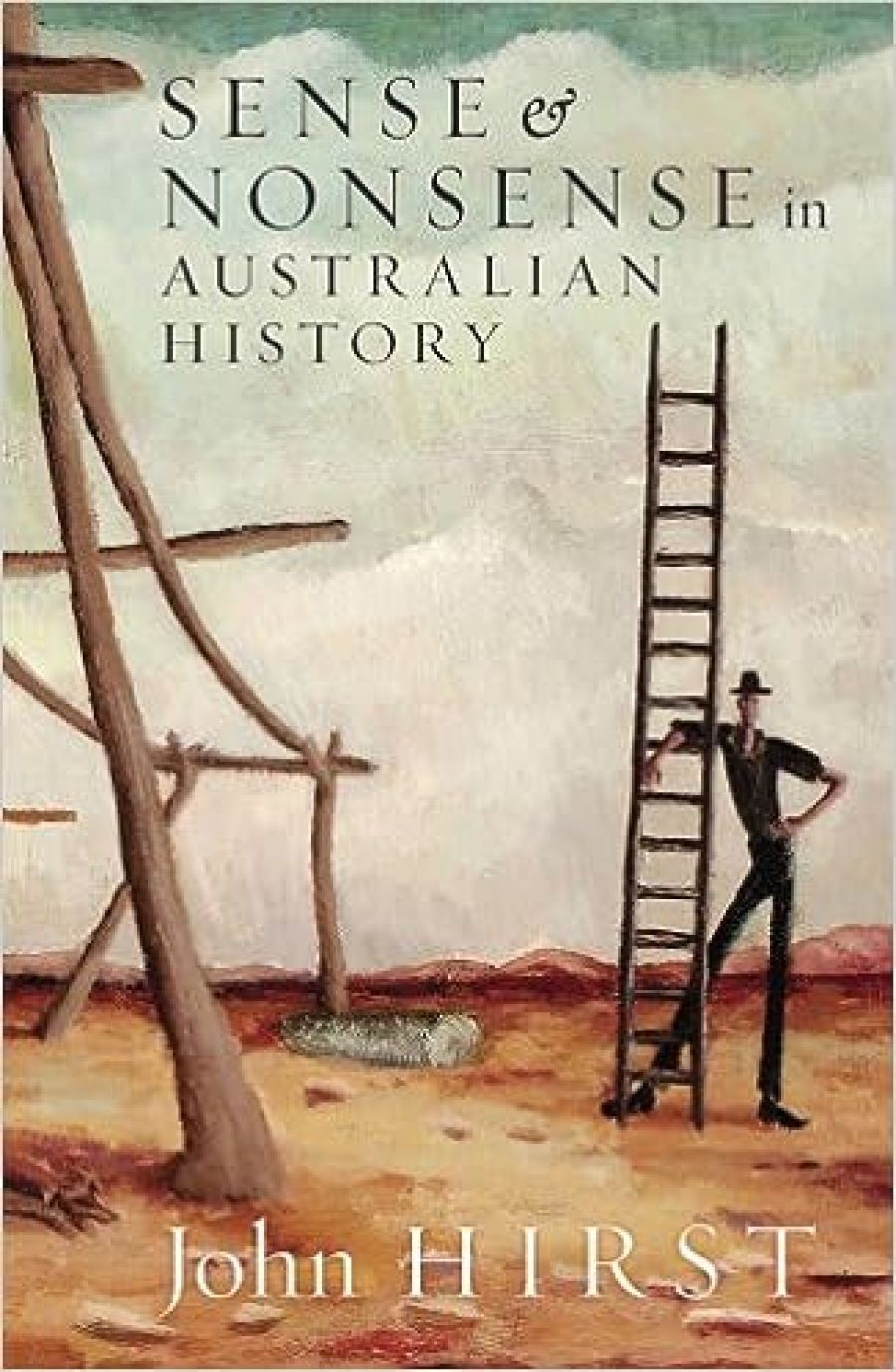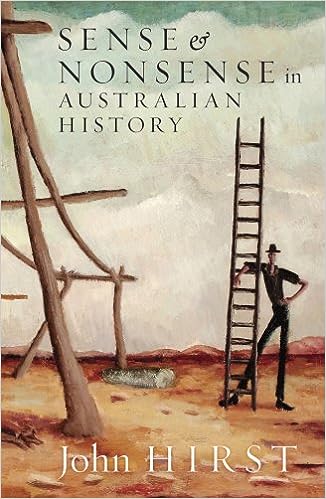
- Free Article: No
- Contents Category: Australian History
- Review Article: Yes
- Article Title: The throwback
- Online Only: No
- Custom Highlight Text:
John Hirst is a throwback. I don’t mean in his political views, but in his sense of his duty as an historian. He belongs to a tradition which, in this country, goes back to the 1870s and 1880s, when the Australian colonies began to feel the influence of German ideas about the right relationship between the humanities and the state. Today it is a tradition increasingly hard to maintain. Under this rubric, both historians and public servants are meant to offer critical and constructive argument about present events and the destiny of the nation. Henry Parkes was an historian of sorts, and he was happy to spend government money on the underpinnings of historical scholarship in Australia. The Historical Records of New South Wales was one obvious result, and that effort, in itself, involved close cooperation between bureaucrats and scholars. Alfred Deakin was likewise a man of considerable scholarship (and more sophisticated than Parkes), whose reading shaped his ideas about national destiny, and who nourished a similar outlook at the bureaucratic level.
- Book 1 Title: Sense and Nonsense in Australian History
- Book 1 Biblio: Black Inc., $34.95 pb, 325 pp
- Book 1 Cover Small (400 x 600):

The picture is not entirely bleak. ABC Radio thrives in all its glory. Many curators in government-funded museums offer (when they are left alone) powerful critical analysis of the long-term evolution of the nation, all the more important because they speak directly to the population at large. So-called ‘third-stream funding’ is also very promising. The Linkage programme of the Australian Research Council funds scholars to work in close cooperation with various commercial, public and community bodies. It is a brilliant scheme (largely unnoticed by critics of government funding for the humanities), and it helps in giving a long-term dimension to many projects of public importance in the city and the bush. From an economic rationalist point of view, this means a fair return to tax-payers. From a civilised point of view, it means harnessing scholarship to public policy.
And yet, the number of first-class historians who write as if they are communicating with government, and with a fair hope of making an impact at the national level, is too small. Hirst takes the idea of the nation very seriously, and he sees his scholarship as a basic contribution to its future. However, even this book – a collection of his most important essays and learned articles since 1975 – shows how hard it is under present circumstances for Australian historians to make a useful impact at that level, while still being true to their trade. Even the most likely academic voice is partly distorted as it struggles to make itself heard.
For one thing, it is now hard to be taken seriously in the wider world without being aggressively one-eyed. This may be why, at the outset of this book, Hirst describes himself as a ‘controversialist-cum-historian’. His title, Sense and Nonsense in Australian History, carries the same message, but it is an accurate label only for the weaker parts of the book, where he goes out of his way to look like a fighter.
In fact, if the ‘history wars’ have done anything useful, it is to expose the problems involved in being an effective controversialist and a good historian at the same time. The difficulty is sharply increased when the basic terms of the controversy are set, not by historians themselves but by others – and, of course, it’s the press, especially the Australian, that now pretends to set the historical agenda for the nation. Some time ago, Luke Slattery, writing in that newspaper, even claimed that in future it would be journalists, not scholars, who posed all the big ideas. Of course, journalists do, and have done, mightily important work: think of Deakin, who wrote for The Age; think of John West, David Syme and so on. But none of these demanded the kind of monopoly some in the press now aspire to. In a single stroke, the authority of intellectual life is undermined and individual scholars are signed up for other people’s wars.
Hirst can be a powerful controversialist, just as he can be a brilliant historian. But his two roles sometimes get in each other’s way. He says in his preface: ‘For over twenty years I have been quarrelling in print with standard left-liberal views of Australian history.’ Here, as a controversialist, he overstates the case for a ‘standard view’. His ‘left-liberal’ orthodoxy is typified, he says, by Russel Ward, Robin Gollan and Ian Turner. Hirst himself is a graduate of Adelaide and Melbourne, and, at least from my perspective (sitting halfway between Sydney and Brisbane), he sees the ‘standard view’ with narrowly southern eyes. Had he been a product of Sydney University, his category of ‘left-liberal’ would have needed stretching somehow to include John Ward and, as our old authorities in print, A.C.V. Melbourne and Stephen Roberts. They were ‘liberal’, but not ‘left’. In other words, there is a sense in which Hirst’s quarrel has a provincial focus rather than a national one. It has been cast in national terms mainly because Quadrant and the Australian want it that way.
Reading on, we almost immediately get a more complicated picture. Hirst is indeed opposed also to ‘liberal’ understandings in the old-fashioned sense. His argument about the causes of Australian Federation, summarised in the introduction (and detailed in his book, The Sentimental Nation: The making of the Australian Commonwealth, 2000), sets aside the old liberal view, which stressed commercial motivations, so as to push the case for nationalist sentiment. A chapter on multiculturalism, written in 1990, carries this logic forward – surely to the extreme limit. The enemies here are the ‘exponents of multiculturalism’, who, he says, ‘are now developing an absurdist history of Australia’. The book has no footnotes, and only one scholar (not an historian) is named. Many readers, recalling the previous chapter, might conclude that the ‘absurdists’ (my term) are the intellectual progeny of Ward, Gollan and Turner – all proponents of the ‘standard view’. Controversy nourishes such silliness.
There are problems of a different kind with Hirst’s chapter on what used to be called ‘women’s history’. The whole approach is sceptical. He concedes to the ‘feminist historians’ much ‘valuable work which no historian can ignore’. But what is surely their most valuable work of all, that mass of energy justly called the ‘new enlightenment’, he himself ignores. This is strange because some of its concerns and insights overlap with his own. Indeed, there are some good portraits of Australia as ‘the sentimental nation’ that draw on a gendered understanding of late-nineteenth-century life and thought – by Marilyn Lake, for instance.
I wish there was more room to say nice things about the book – to list all the evidence of Hirst’s originality of thought, his courage and clear moral sense. His piece on the ‘pioneer legend’, about the sense of patriotic tradition that was fundamental throughout Australia from the late nineteenth century, is one of the most important articles Historical Studies has ever published. Thirty years on, it has a continuing usefulness, and the slant it offers remains central to the Australian story. His ‘sentimental nation’ argument is not wholly convincing, because the main evidence is a sample of late-nineteenth century poems, but his fundamental question – what if emotion was the fundamental cause of Federation? – is bold and important. It is especially innovative in focusing on men’s emotions (though he doesn’t state the case like that himself). In much of Hirst’s writing, there is a driving search for simplicity, for a way around intellectual abstractions and for the merely human, and the result can be very rich.
For the moment, the flaws in his approach are more intriguing. In parts of this book (and in his Strange Birth of Colonial Democracy, 1988), Hirst identifies Australia’s ‘democracy of manners’. By this he meant an egalitarianism manifest predominantly in the way people deal with each other in daily life. Created mainly, he says, in the 1880s and 1890s, it still exists, as a form of civility fundamental to Australian culture, and therefore fundamental to the national constitution (meaning ‘constitution’ in the widest sense).
But the argument is too loose-ended. What is the relationship between Australian national sentiment and Australian civility? What about other forms of solidarity? With such shaky underpinning, sometimes the scholarship comes unstuck. For instance, Hirst says that in the late nineteenth century the Catholic bishops set up their own schools because they didn’t understand Australia’s virtues. Deluded by their Irish experience, they wrongly believed that government schools were designed ‘to undermine their faith’. Here, he badly underrates Catholic understanding and the real threat posed to spiritual life by secular habits and ideas. In fact, he sounds like the more facile kind of multiculturalist – the kind who thinks that spiritual loyalties are, or ought to be, no more than one thread in the rich tapestry of the modern nation. It is possible to take the nation too seriously.
Excessive seriousness has real risks. The only chapter written especially for this publication is called ‘How Sorry Can We Be?’, and it deals with indigenous issues. Hirst, it hardly needs saying, dismisses Keith Windschuttle’s logic about the number of Aboriginal deaths on the frontier. On the other hand, he condemns the High Court judgment in Mabo (1992). There may be good reasons for doing that, but Hirst’s are not good. He describes the judgment as one based on ‘liberal fantasy’, the notion that the British acquisition of Australia could have been achieved without damage to the indigenous people. The judges, in other words, should have understood that the civilisation of which they were a part was only possible because of numerous Aboriginal deaths. Armed with that understanding, they should have withheld their condemnation of ‘past injustices’.
Genuine critical thought, with discrete moral and intellectual priorities, has apparently been outlawed among public servants. Historians who try it are also supposed to be wasting public money. But surely, in this respect, the High Court is safe. Surely, their ancient, arcane methods of the law still have an unfailing momentum and purpose, standing for something beyond immediate prejudice. Hirst suggests that justice ought to be defined, not according to strictly legal criteria, but according to its impact on the nation. Aboriginal deaths were necessary, he says. Therefore the killing was not unjust. There couldn’t be a better proof that taking the nation too seriously can hit at the heart of what the nation is really for.
It almost seems pretentious to suggest that the historical profession ought to be as self-sufficient in its intellectual agenda, and therefore as useful, as a court of law. But if that does seem pretentious, it only shows how badly off track we are.


Comments powered by CComment